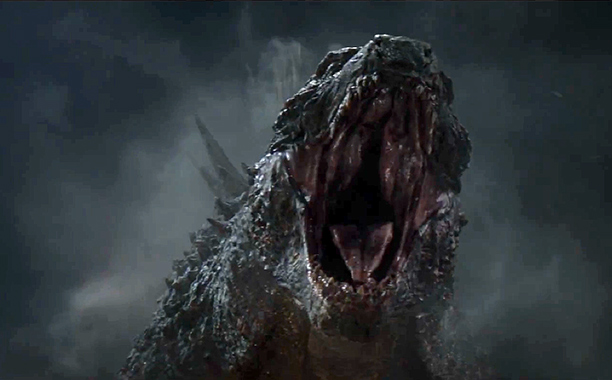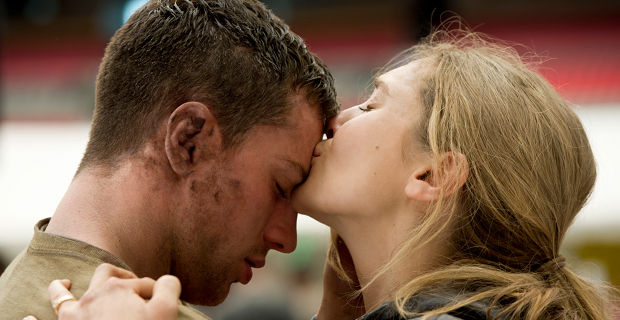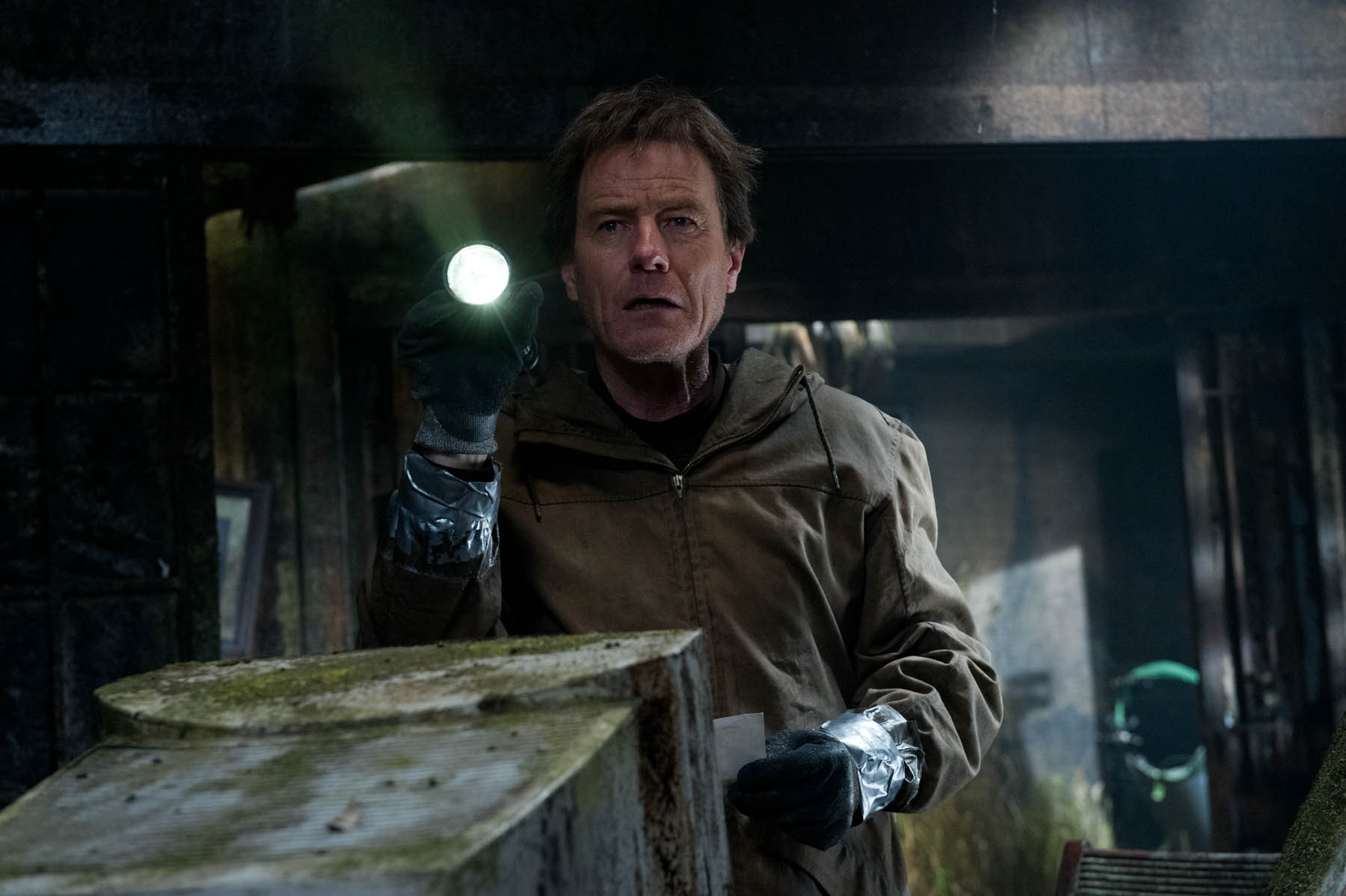The Bad:
5. Needs Its Own Identity
While Godzilla ended up being just an entertaining and satisfying film overall, it was actually kind of average. Gareth Edwards shows a heavy Spielburg influence during most of the two hour and three minute runtime; giving us teaser shots of Godzilla here and there, building up to a full reveal at A Hawaiian airport where he faces his opposing creature on the runway. The moment was well done and built up to perfectly, but this is where Edwards starts to falter.
After the big reveal, Godzilla returns to tease the audience with short segments of footage until the climax of the third act, we almost see the other creature more than we do Godzilla. This is especially upsetting because in the digital age we live in, we were subjected to A LOT of pictures of Godzilla in full and glorious view which rendered the tension building, while well done, pointless. Why spend so much time keeping the principal attraction in the shadows when the entire world already knows what he looks like?
Edwards tries to make his film almost too much like Jaws, rather than giving us long shots of Godzilla tearing apart his enemy and reducing San Francisco to rubble after his full reveal, we are given more Ford Brody, the United States Military, and the human story with Godzilla and his battle to balance nature as the background for humanity’s struggle to deal with, and accept what nature was actually throwing at them. It really leaves you wanting more Godzilla, and less Ford Brody. Yes, it was a cool idea to look at Godzilla from the perspective of humanity dealing with a natural disaster, but that shouldn’t have pushed the creature that everybody wanted to see into the background. The film could have played better if Edwards could have created the films own identity, rather than borrowing so heavily from Jaws.
4. Writing
There are something’s that I didn’t understand about the way that Max Borenstein wrote his characters but I’ll cover that in a moment. Borenstein hasn’t really penned anything worth noting, and the same goes for Godzilla. The dialogue between characters comes off as cliché and sort of cheesy, events have little to no weight behind them because of poor use of a great first act, and characters are just thrown into situations for no other reason but to be in the action.
The script felt more like a 90’s action flick instead of a modern Disaster/Giant Monster epic and as a result, we are given the heroic efforts of the always well placed Mr. Ford Brody; saving children, running from giant monsters, and disarming bombs for most of the film. Borenstein never reached into the depths of his characters to develop a story around them, but more so used them like pawns on a chessboard; slowly and blandly moving around the King in ways that could make sense, but ultimately are put into place for no reason at all. Which brings me to my next point…
3. Under-Developed Characters
Outside of Bryan Cranston’s Joe Brody, (who was underutilized) all of the human characters are drastically under developed. For example: We are given one scene to establish an emotional connection with Aaron Taylor-Johnson’s Ford Brody and Elizabeth Olsen’s Elle Brody, before Ford is called away to start his adventure in Japan. There isn’t enough time for Johnson and Olsen’s chemistry to develop because they barely spend any time together on-screen; this suffocates the motivations of our hero to tirelessly make his way back to his family, and provides for a pretty basic film experience for a film that was supposed to be driven by its human characters.
Ken Watanabe gives a fine performance as Dr. Ishiro Serizawa, who provides the audience with an emotional connection to Godzilla. He understands the purpose of this gargantuan beast, who he refers to as a god, and is desperately trying to persuade the Navy to allow Godzilla to put nature back into balance. Although the performance is decent, Watanabe can’t fix shoddy writing. His character is played with great emotion but we never really know why, and when we gain a brief look into the history of his character through a quick exchange of words and a few glimpses of a watch; the moment never really hits home because when we initially meet him in the film, he is just thrust into action along with everyone else.
The poor development of characters hinders the films emotion, and lacks in the area that it tried to make its strongest. Gareth Edwards tried to ground Godzilla firmly in reality and tried to approach him as a natural disaster. While the disaster portion of the movie was solid and enjoyable; the human element missed and made for a dethatched viewing experience.
2. No Emotional Investment
Godzilla portrayed a lot of emotion through its characters, but didn’t convey it to its audience at all through exposition or story. We are almost shot from a cannon at the beginning of the film and asked to sponge in the emotions of the first act. Once we reach the second in a daze; the film limps into its third act on the back of decent acting, and the sights of a villainous monstrosity tearing its way toward California.
Even though the third act was far better than the second, and provided with a lot of pleasurable disaster viewing; the emotion falls flat in some of the films more crucial moments that seem to play more toward the audience’s nostalgia for Godzilla, rather than the emotions conveyed in the previous events of the film. We are never given a moment that carries proper emotional weight after the events of the beginning of the film, and everything that happens thereafter just seems to happen for the convenience of the story.
1. The Second Act
After a really great, suspenseful, and emotional first act, Gareth Edwards used the middle of his disaster epic to build to the climatic reveal of Godzilla in his full bodied and stoic beauty. I touched on this before, but let me elaborate; Godzilla is revealed in Hawaii after the evil monster which is referred to as a M.U.T.O. in the film, (Massive Underwater Terrestrial Object) is causing havoc at the airport where Ford Brody is trying to catch a ride back home to San Francisco. There is a really cool, slow moving shot across large glass windows that show us explosions, only for the humungous foot of our beloved Godzilla to come crashing into view; truly showing the audience how massive the monster really is. We cut to the outside and pan up his body to reveal his face, where he lets out a great roar. The moment is unforgettable, and is a defining moment for our Godzilla for a new generation.
Instead of building on the reveal of Godzilla, Edwards decides to plunge him into the shadows again for the remainder of the second act and make him a background feature for the humans to worry about and deal with until the third act. Edwards’ decision to take the “less is more” route again after revealing it all when he probably should have balanced the human side with the monster side makes his film suffer, especially with the lack of human character emotion/development. The audience has no proper filler when Godzilla is off screen, granted you are treated to mayhem from the M.U.T.O. in the meantime, but it isn’t fulfilling enough to see an average action movie while you wait to be treated to the film you were promised in trailers.
When it is all said and done, I believe Godzilla was a victim of its own marketing. The plethora of juicy stills, epic trailers, and t.v. spots provided us with too much of what Edwards seemingly wanted to remain a little more hidden in the film. While satisfying enough to not disappoint, Godzilla delivers in the visual department in almost every way; especially when he is gracing the screen. The set pieces between the monsters are very enjoyable, but should have been longer, and the human element could have been written a lot better. Overall, Godzilla is an enjoyable summer, popcorn, blockbuster action film that will settle the need inside fans to see the King of the Monsters back on the silver screen in a respectable and well represented way, and has revived the legend of the monster in a well received light that will surely send it into a bright future with a prosperous pool of ideas to work with.
Author Bio: Nick LaMacchia is from Buffalo, NY. While currently residing in Portland, OR, he is writing a sci-fi trilogy of novels, with the first being published late in the year. He’s obsessed with film, football, hockey, Batman, and real chicken wings from his hometown.


